本文由 Tato Architects 授权mooool发表,欢迎转发,禁止以mooool编辑版本转载。
Thanks Tato Architects for authorizing the publication of the project on mooool, Text description provided by Tato Architects.
Tato Architects:在夏日结束之际,这个“小村庄”如海市蜃楼般在一所小学的校园里浮现又消失。“Kagerou”在日语中有海市蜃楼和幻境的意思,Kagerou Village是由多个展亭构成的临时展览,包含了一系列临时展亭,分别由来自德国、法国和日本的建筑师设计并建造。展览所在的学校原由当地居民出资建造,如今废弃的场地被用作艺术中心。在由建筑历史学家五十岚太郎主持的一次公共研讨会上,来自不同国家的六位建筑师共同探讨和分析了场地和项目的潜力,随后又在日本全国范围内进行了数次会议,最终决定在这处废弃的学校空地上建造这座“小村展亭”,营造一系列实用的公共空间。
Tato Architects:The village that appeared and disappeared in the school grounds of a former elementary school like a mirage at the end of summer. The extemporaneous exhibition was created in the schoolyard of a former school, founded by the donations of local citizen’s, now used as an art center. The Kagerou Village, Kagerou meaning Mirage, was composed of a series of temporary pavilions designed and build by a group of architects from Germany, France and Japan. Beforehand the six architects of different nationalities met, to discuss the potentials of the site and project, at a public symposium supervised by architectural historian, Taro Igarashi. Following the symposium, several meetings took place across the countries and it was decided to build the village of pavilions to create a series of practical public spaces in the rarely used schoolyard.
▽场地俯瞰 Overall view of ground
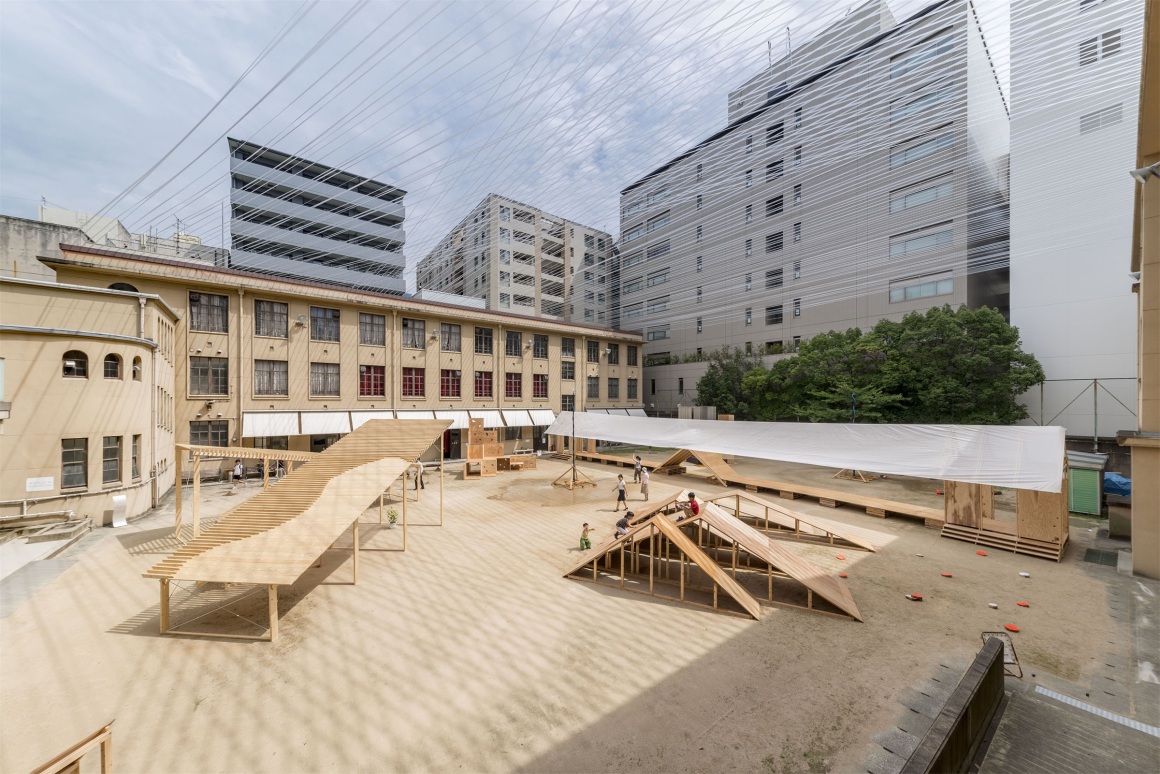
度态建筑 dot architects
所有展亭都是在5天的时间内建成的,度态建筑在其中担任施工负责人。受京都当地建筑“町屋”的传统屋顶的启发,度态建筑创造了一系列不同梯度的滑梯,以鼓励孩子们玩耍并激发他们的好奇心。同时他们还建造了一个喷水塔,喷洒薄雾以产生凉爽的微风。
All pavilions was built over a 5-day period, where dot architects acted as the main supervisor of the construction. Inspired by the successions of traditional roofs on the local Kyoto Townhouses ‘Kyomachiya‘, dot architects created a series of slides with different gradients to encourage play and pique children’s curiosity. They also build a sprinkler tower spraying mist to create a cool breeze.
▽“町屋”式滑梯屋顶 MACHIYA slider roof

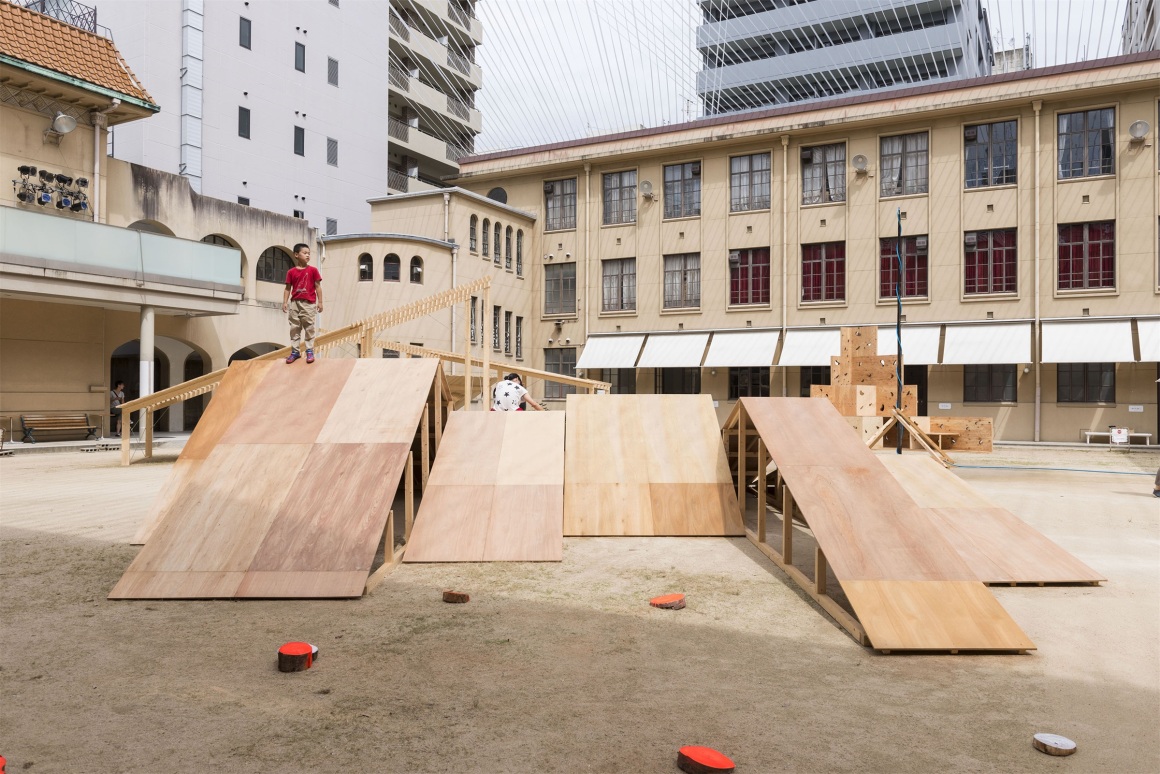
▽ 观众坐在自己喜欢的位置 Audience sit down on each favorite spots
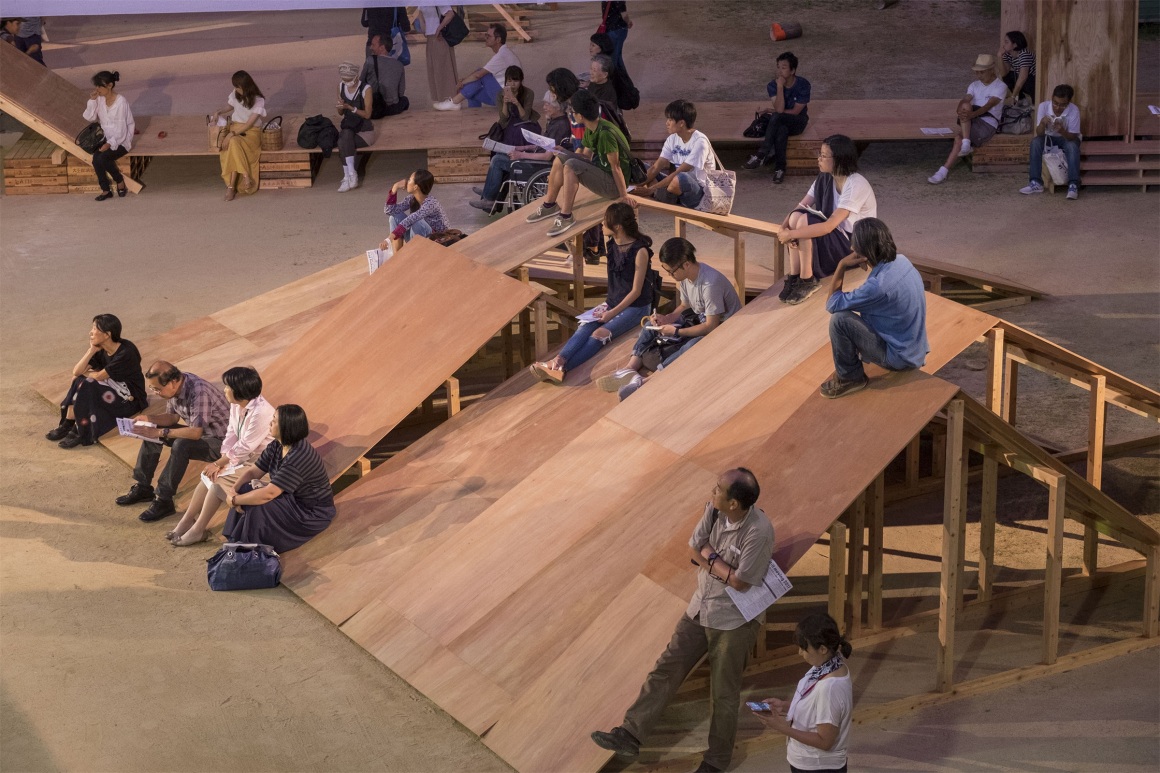
Hiroshi Kato
Hiroshi Kato创造性地利用了该场地,在开阔的场地上空编织了几条乙烯基胶带以连接天空和地面,让它们在地面上留下条纹阴影,并在下方布置了由场地原有的原木和杂草制成的长凳,使整个展厅变成了一个巨大的房间。当阳光洒落,微风拂过时,地面的投影像沙沙作响的树叶一样律动。项目本身和其自然效果极大的吸引了视听感官,并与当地背景以及历史悠久的纺织品批发商息息相关。
Connecting the sky and ground, Hiroshi Kato creatively took advantage of the site, by weaving several vinyl tapes across the open sky allowing them to cast striated marks on the ground where he designed humorous benches made of logs and weeds from the schoolyard. By doing this, he rendered the whole site into a huge room. When the sunshine falls and the wind blows into the courtyard, the shadows imitate the shape of rustling leaves. The project and natural effects appeal to the visual and auditory senses, and relates to the local context the surrounding area with its long-established local textile wholesalers.
▽原木和杂草制成的长凳 A Garden of Kyo-Zasso

▽律动的胶带 Weaving between

Sébastien Martinez Barat and Benjamin Lafore
Sébastien Martinez Barat和Benjamin Lafore的作品The Welcoming folly以其层次分明的条纹和曲线图案欢迎并引导参观者,这些图案由垂直交叉排列的线性格栅与弧形板面制成。尺寸和间隔不一的格栅支撑起整个结构,创造了一个带有织物纹理般复杂阴影的私密空间。
The Welcoming folly, by Benjamin Lafore and Sébastien Martinez Barat, welcomed and guided the visitors with its layered patterns of stripes and curves, created by linear louvers interlocking at 90 degrees angels with curved planes and its shadows. The louvers create patterns varying in size and gradient that engineer the whole structure, resulting in a space that creates an intimate room with complex shadows like fabric layers.
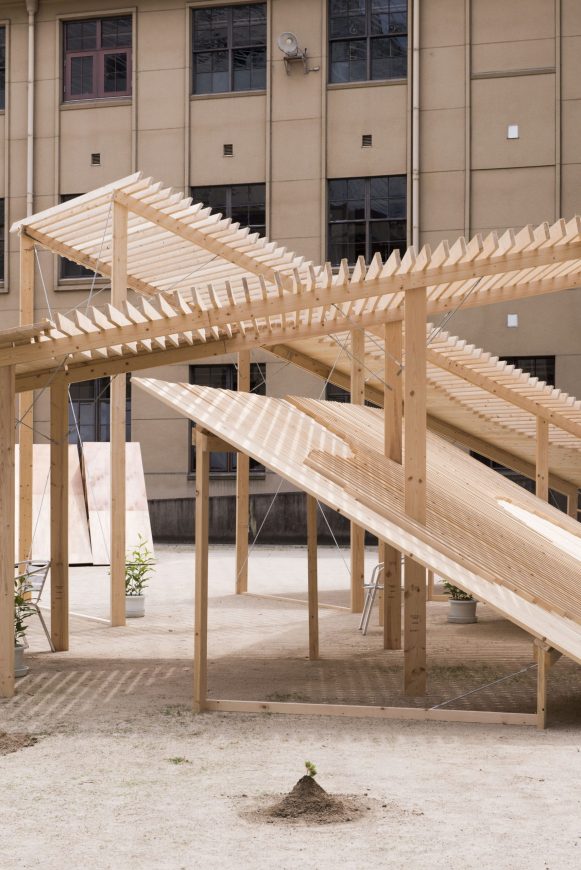

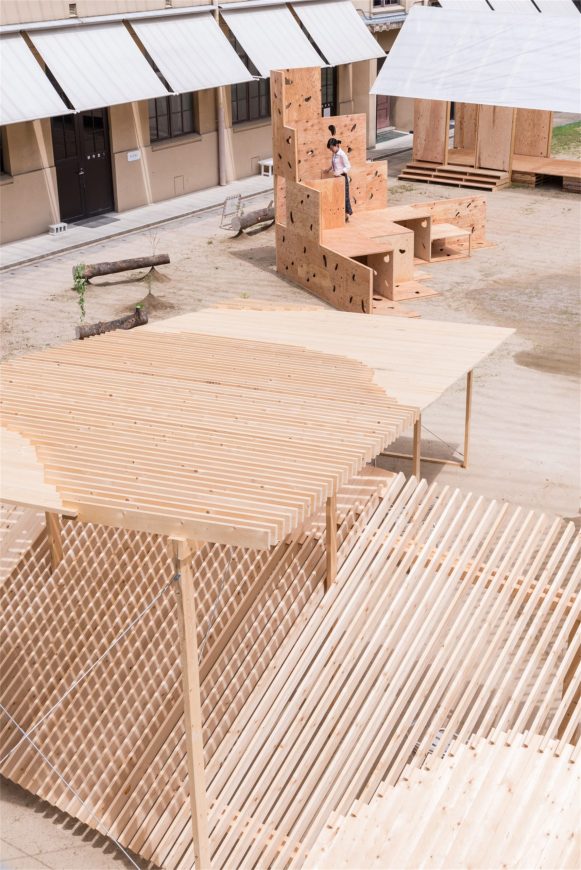
Yo Shimada / Tato Architects
该展亭位于两座相互相对的旧教学楼之间,Yo Shimada利用一块6m x 30m的农用织物连接两栋建筑的入口,并在下方制作了一个木制甲板供孩子们玩耍,使得场地的两个部分之间畅通无阻,孩子们可以通过抬高的木板爬到顶端触摸织物并从另一侧滑下。通道类似于日本神龛的廊台“Engawa”,游客可以在此小睡、聚会或玩耍。
Paying attention to the entrances of the two old school buildings facing each other, Yo Shimada chose to connect the two entrances with a long corridor like space, by stretching out a 6mx30m piece of agricultural fabric across the courtyard. Beneath the fabric roof, a wooden deck invites to play, where kids can run back and forth, climb the raised path, which allows unobstructed passage between the two parts of the courtyard, touch the fabric and slide down on the other side. The corridor resembles an ‘Engawa‘, the veranda of a Japanese Shrine, and invites visitors to take a nap, get-together or play.

▽孩子们在装置中玩耍 Children run up corridor which partly acts as slider

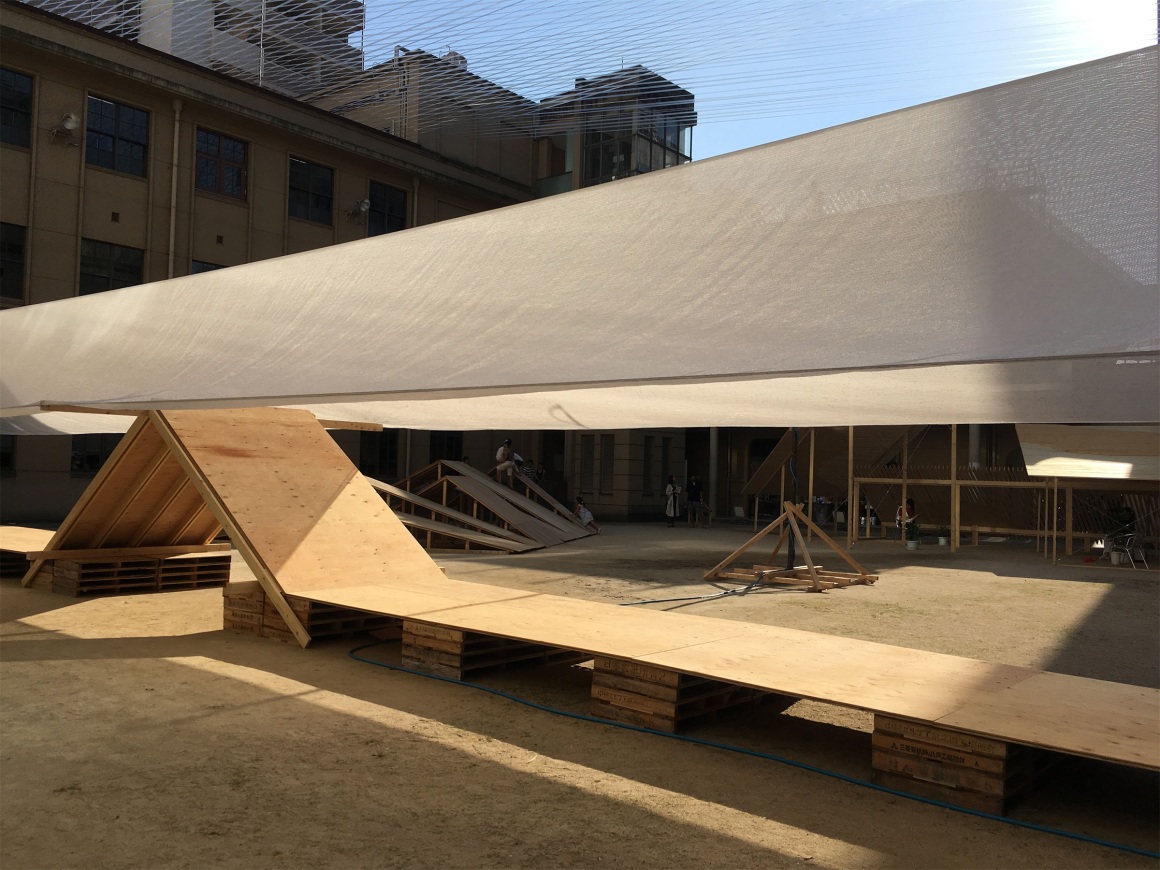
Ludwig Heimbach
Ludwig Heimbach在场地的边角采用一系列用胶合板和织物包裹的框架创造了一个复杂的小屋结构,旨在让游客,尤其是情侣,在一定程度上避开顽皮的孩子进行私密的对话。该装置还可用作鸟类的饮水器,展亭通过这种方式表达公共空间应该涵盖各种私人区域和可能性。
In the far corner of the schoolyard, Ludwig Heimbach, joined a series of frames clad in plywood and fabric, creating a complex cabin structure where he intended for the visitors, lovers in particular, to engage in their secret conversations partly sheltered from playful kids. The structure also functions as a drinking fountain for birds. In this way, the pavilion suggests that a public space should include various private areas and possibilities.
▽给人精神上的愉悦 A Float of Immaterial Pleasure
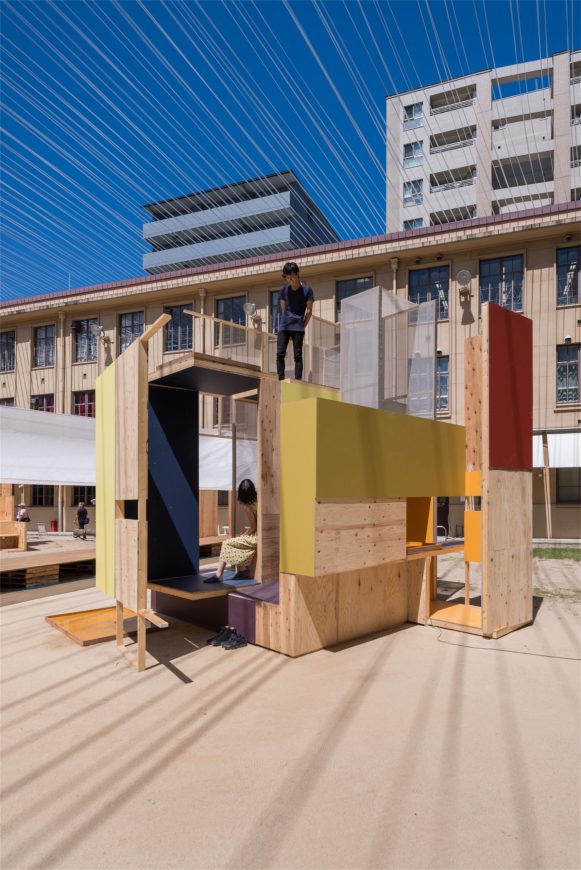
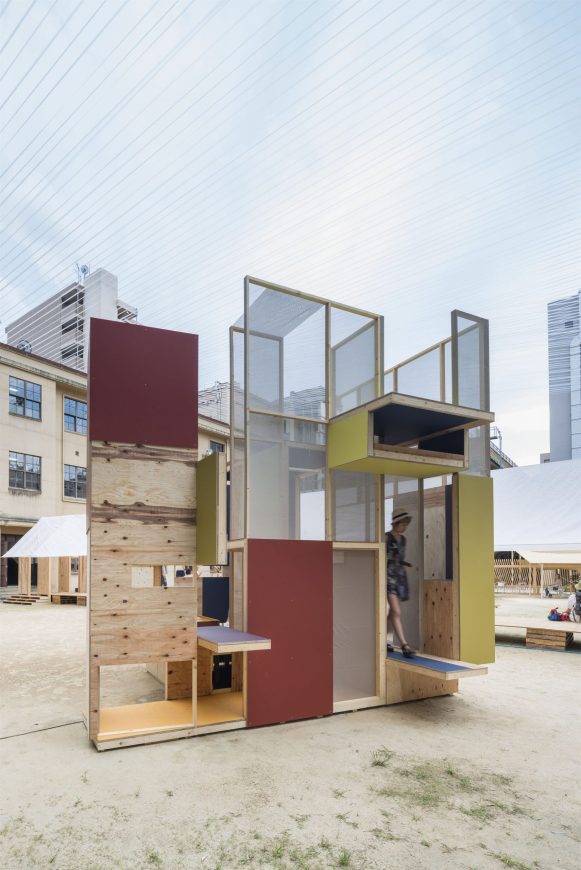
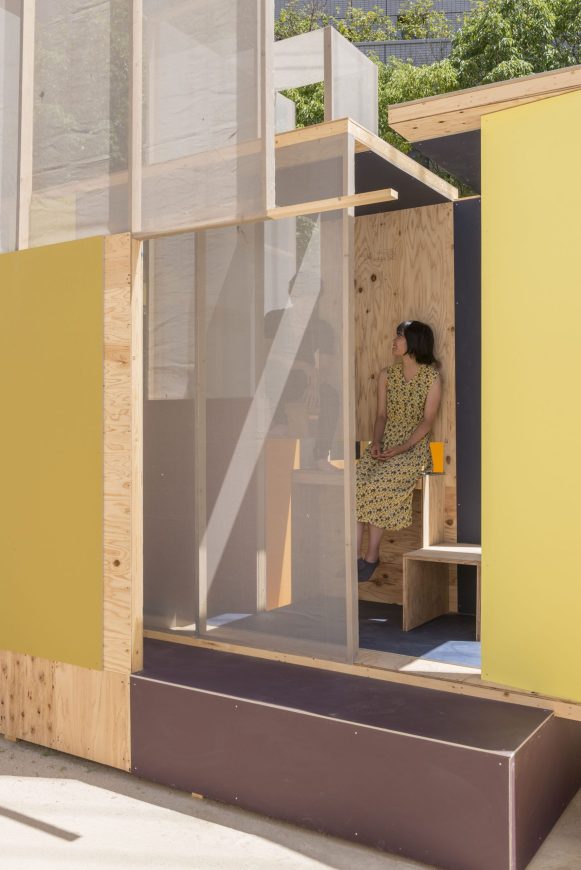
Sven Pfeiffer
Sven Pfeiffer利用钻孔胶合板搭建了这个名为“危险游乐场”的多孔攀爬装置。在展览的最后一天,这个多孔的藏身之处被拆解并堆成一堆,成为了一个名副其实的危险场所。
By erecting and drilling holes in a plywood structure, Sven Pfeiffer created an inverted bouldering pavilion titled ‘dangerous playground‘. On the final day when this porous hideout was disassembled and staked into a pile, it too became a dangerous place to play.
▽危险游乐场 Risky Playground


▽从内部看天空 Looking up sky from inside
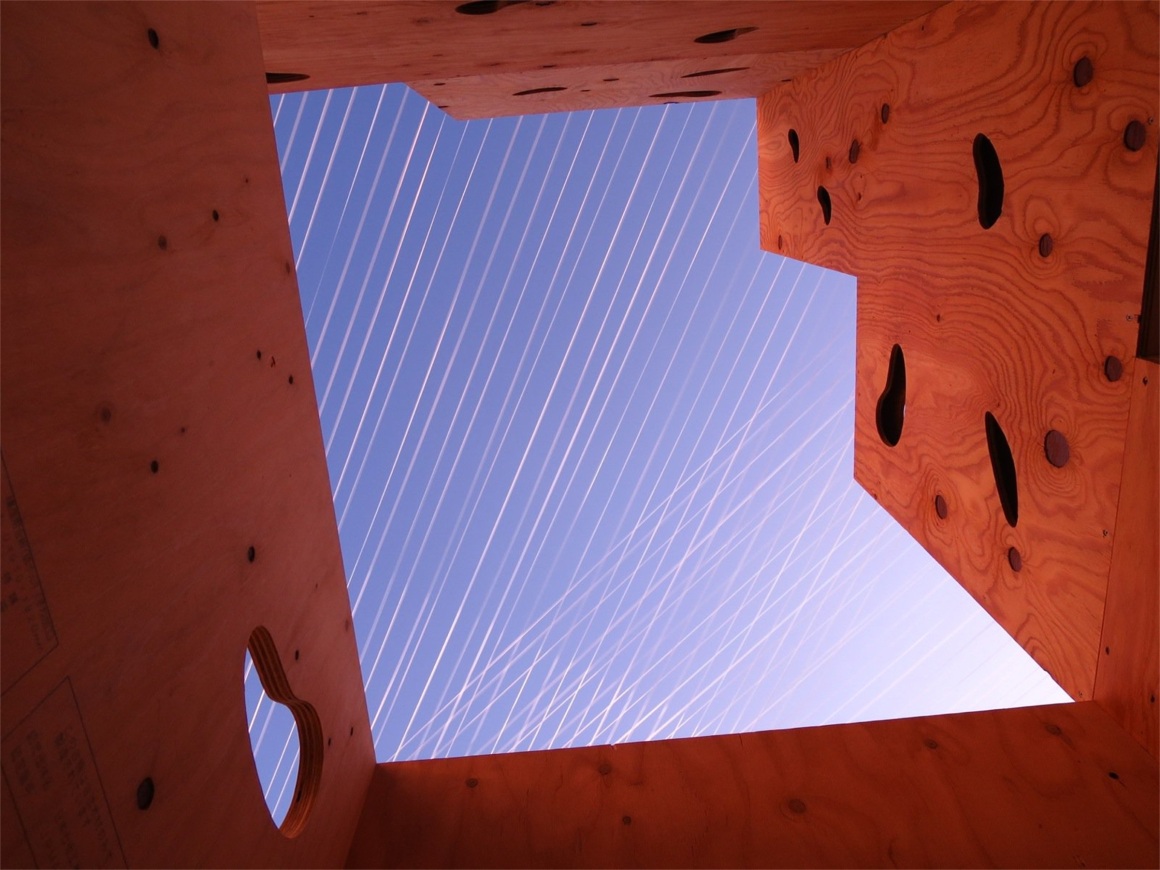
正如Sven的作品“危险游乐场”所表达的那样,Sven、Shimada和dot Architects的作品旨在通过提供日本公共空间通常排斥的“潜在游乐场危险”来激发青春和活力。织物的使用和它的参照在这些作品中反复出现,Shimada和Ludwig 在与当地纺织品批发商的文化关系中使用织物,Kato采用了折叠带状花边,而Sébastien和Benjamin创造了让人联想到织物的重叠阴影。各个展亭相互影响,形成了这个村庄的整体。
As the name of Sven´s work ‘dangerous playground‘ suggests, the intention of Sven, Shimada and dot architects works was to arouse youth and vigor by providing ‘the potential playground danger‘ that Japanese public space generally excludes. The use of fabric or it references is recurrent in the works, Shimada and Ludwig used fabric in cultural relation to the local textile wholesalers, Kato folded tapes like lacework, while Sébastien and Benjamin created overlaying shadows reminiscent of fabric. The pavilions mutually influenced one another and as a whole created a village.
第一次研讨会的主要讨论的主题之一是关于日本公共场所禁止事项。在这个像海市蜃楼一样出现又消失的村庄里,设计师表达的想法不是“不做”,而是“如果我们做呢?”。
One of the main discussions of the first symposium had been on the topic of prohibited matters in Japanese public spaces. In this village that appeared and disappeared like a mirage, the thoughts was not ‘do not do‘ instead it became ‘what if we do?‘.
儿童和成人都可以在The Kagerou Village获得享受,尽管存在“危险”,但他们现在可以主观地提出“如果事情可行,为什么不做呢?”的问题。虽然展览是一个特定的场景,但希望人们从现在开始重新思考公共空间的意义。
The Kagerou Village became a place children and adults alike could enjoy, despite the ‘dangers‘, allowing them to now subjectively raise questions as ‘if various things are doable, why not?‘. While an exhibition is a specific scenario, hopefully it becomes an opportunity to rethink the approach to public space from now on.
项目地点:日本,京都
建造时间:2017年
Location: Kyoto
Construction: 2017
“ 六个形态各异的展亭聚焦对公共空间意义的思考。”
审稿编辑: gentlebeats
更多 Read more about: Tato Architects




0 Comments